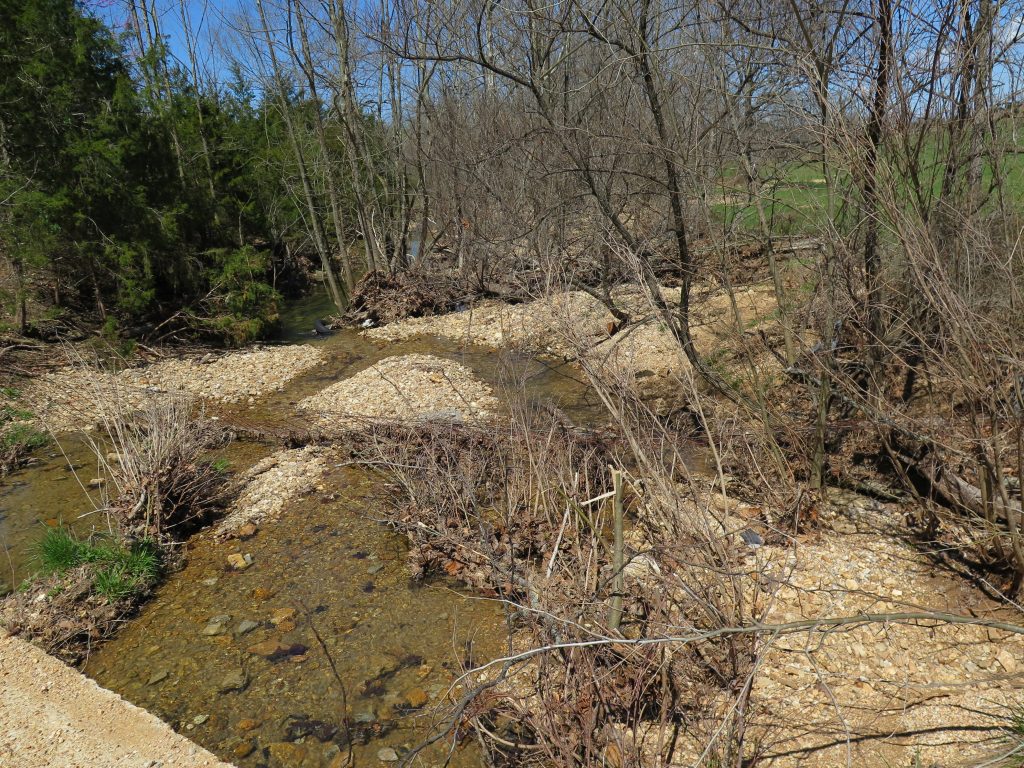
The Streams Aren’t What They Used to Be…
Fishing holes have disappeared, springs have dried up, and many other changes have come to our streams. Can a change of vegetation reverse this trend?
“When I was a boy, that used to be a good fishing hole,” says Rex Hamilton while standing on the banks of Hog Creek. “We would catch perch and little brown bass and see hog mollies [suckers]. And my dad, Emerson, used to tell me that the fish were abundant enough that they used a seine, a large net that two people pulled upstream, here in the same creek to catch a meal of fish.” Today, there is not enough water here to keep a minnow alive through the summer.

“And that spring there,” Rex continues, “was where my Grandpa Joe would get a drink when he was out working in the fields during the summers.” Nowadays, that spring is so dry that not even a local squirrel can get a drink except during the wettest of times.
“But here, in this little branch and the spring upstream from here,” he says while pointing to a very small stream branching off of Hog Creek, “we are seeing change. Could we, one day, see enough change for my grandkids and great grandkids to fish the creek, once again? Could the floods of spring bring a renewed supply of fish, up the creek to nest, like we used to see?”
The changes in the stream aren’t just an isolated memory. Other old timers in the Ozark hills talk about the changes in the streams and fishing. This conversation isn’t unique to the Ozarks. Old timers from Audrain County in the flat, prairie landscape of north Missouri tell how they could catch a mess of fish in Sandy Creek, but shortly after the first soybeans were planted in the fields, the creek began to silt in and today there is no dinner to be had from that part of the creek.
The old timers sometimes sit around and discuss the reason for these changes. The land has seen a lot of change since settlement: raising crops, mass logging of trees, open range and overgrazing, and the destruction of plants in the streams and on the banks of the stream to name a few. In different parts of the Midwest, the thoughts about why the streams have changed are different, but the story that the streams have changed seems to be universal.
Research backs up that changes have occurred. A study in the tallgrass prairie showed that where the prairie remains the streams have less flooding (lower peak flow) and more of the stream flow is derived from groundwater flow (greater base flow component) than in similar streams surrounded by agricultural land1. The increase in floods and sharp rises and falls in stream levels in agricultural watersheds can also change the shape of the stream. This research points to some of the reasons that we are seeing changes in our streams and demonstrates the importance of the grassland plants to our stream health.
As Rex begins walking up the very small stream to the spring where he is seeing improvement, he talks more about the changes that he is seeing. He points to the spring and notes, “Twenty years ago, this spring only flowed in wet weather. However, today it has visible aboveground flow nearly all summer, and even in the recent droughts you could get a drink here.”
“I think that the secret is in the vegetation changes.” Rex shifts his gaze from the spring to the valley further upstream. “The changes we have seen here in this little stream’s watershed in the last 20 years are mostly vegetation changes.”
Looking to the hills, Rex states, “Where there used to be many acres of fescue, a non-native grass, now there are only a handful of acres of this grass and the others have been replaced with native plants.” Rex continues, “We have measured that the soil in our fescue fields absorbs less water than the soil in our native fields, and if less water runs into the soil, there is less water to eventually filter into the spring.” (Read more about this in Land that Drinks in the Rain.)
“Another change that has happened above this spring” says Rex as he points up the valley, “is that the invading cedar trees have been cut and native plants have been planted on the thin-soiled, rocky glades.” Rex adds, “It is commonly observed in other areas where cedars grow that removing the cedars, which have a high demand for water, will bring back springs, and I think that is part of what has brought this spring back too.”
“Also, above this spring, we thinned some of the forests and planted native plants beneath the remaining trees to create savannas and open woodlands,” Rex says while looking at one of those hillsides, which is scattered with trees and has a profusion of native grasses and wildflowers covering the land beneath the trees. “We have measured with infiltration tests here on our land that more rain runs into the soil when there are native grasses and wildflowers growing rather than the ground only being covered with fallen leaves.” Rex continued, “basically, the native plants encourage water to flow into the soil and this water can slowly filter through the soil to show up in the springs.”
“This is only an observation from a small watershed,” Rex related, “but I think that the thing that excites me most about this is that I think we can make these changes on bigger watersheds and begin to heal our streams.”
Join Rex in this video as he talks about pre-settlement streams.
1 The study comparing tallgrass prairie watershed to agricultural watersheds was done by David Heimann and Dale Blevins and a summary can be found in the Missouri Prairie Journal, Volume 31 number 1.


